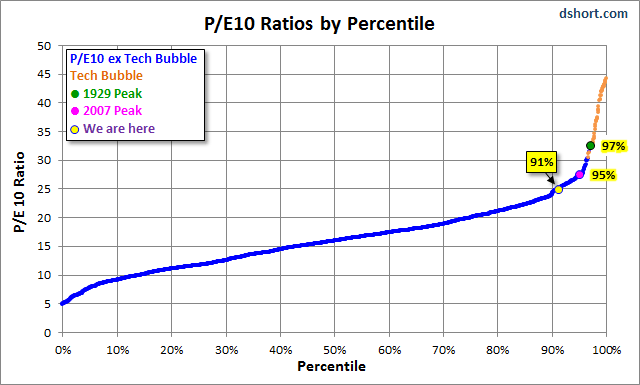How long can this market stay overvalued
Post on: 16 Март, 2015 No Comment

Man stuck on the top of mountain, stock market concept (Photo: Getty Images/iStockphoto)
On Monday, July 14, the Dow Jones Industrial Average hit another record high. As stock prices soar higher, their price/earnings ratios increase, making the stocks more expensive. The obvious drawback to buying stocks in an expensive market is that there is a higher probability of larger losses in the event of a pullback, and long-term returns can be muted.
Many commentators are currently focusing more attention on Yale Professor Robert Shiller’s Cyclically-Adjusted Price/Earnings Ratio or CAPE, rather than the trailing twelve-month P/E ratio, which is currently 19.6. (The median is 14.56.)
Using Shiller’s formula of averaging earnings over a 10-year time frame, the CAPE (also known as the P/E 10) is currently 26.19 – which tells you that stocks are almost as expensive as they were in 2007 – just before the financial crisis. (The median is 15.93.) As a result of comparing the current Shiller CAPE to the median, we can see that the market is currently overvalued by approximately 60%.
Other metrics also point to the possibility of overvaluation in today’s stock market.
Warren Buffett has one that he likes that compares market capitalization to GDP, and it is currently at a level similar to that of 2007. Other measurements like P/E ratios, price/book ratio and Q ratio all point to historically elevated levels of valuation in today’s stock market.
At this point, investors are playing a guessing game, wondering how long the market can stay overvalued. How long can the major stock indices continue to run higher before a pullback occurs? Since we have seen two major bear markets with 50% declines since 2000, this is now, literally, a multibillion-dollar question.
The fact is that no one knows how long this market can stay overvalued. The mere fact that the market is overvalued will not necessarily cause a pullback or correction to occur. In fact, the stock market remained quite comfortable with a CAPE above 25 for many years before the financial crisis. Nevertheless, history tells us that this time is never different and therefore we live in dangerous times.
So what could be a trigger for a return to more normal valuations?
Most analysts say that the low interest rates which have resulted from the Federal Reserve’s quantitative easing program have helped push more money into the stock market and are responsible for today’s overvaluation. Based on that assumption, the most likely catalyst for a stock market sell-off could be the end of quantitative easing and the beginning of interest rate hikes, which appear to be growing ever closer.
The Fed has already announced its intention to stop its bond-buying program in October, and on July 15, Fed Chair Janet Yellen appeared before Congress and said that rate hikes could come sooner than previously anticipated. Interestingly, the Fed has also pointed out the potential for asset bubbles in hot sectors like biotechnology and social media, which is a significant departure from usual policy.
Markets responded to Dr. Yellen’s point of view with some hesitation, since rising interest rates eventually make stocks less attractive. Adding to the suspense, this possibility comes at a time when retail investors have been pouring into the stock market and major indexes hover near record highs.
So how can we know when stock market valuations have gotten too high and a correction is at hand?
Clues can be found in many places, the first of which is over-exuberance and complacency, which are certainly in play today. Another is to listen to the Fed telegraph its intention to raise interest rates. Technical traders will be watching for declines below important moving averages like the 50- and 200-day levels, which usually signify short- and longer-term weakness. The current earnings season could also give a hint, particularly by listening to forward guidance from bellwhether companies in important sectors like technology, transportation and financials.
Corrections themselves can provide opportunity if people can conserve assets in cash or through balanced, diversified portfolios. It’s also possible to seek gains in vehicles like bonds or inverse ETFs that tend to rise as broad equity classes decline. But the biggest opportunities usually come when the storm is over, like we saw at the end of the tech wreck in 2003 and the end of the 2008-2009 bear market — which gave way to years of solid gains.
The stock market could stay overvalued for longer than any of us can imagine, but the bottom line remains the same, this time is never different.
John Nyaradi is publisher of Wall Street Sector Selector , a financial media site and newsletter focused on ETFs and global financial analysis that is a USA TODAY content partner offering financial news and commentary. Its content is produced independently of USA TODAY.














